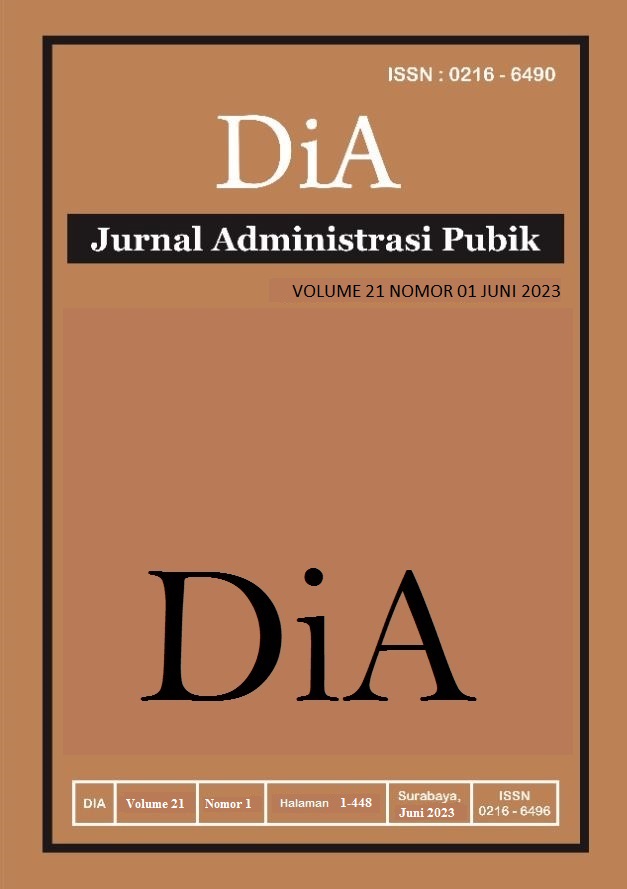MANAGEMENT AND IMPROVEMENT OF HUMAN RESOURCES ORIENTED TO GLOBAL MARKET COMPETITION: CASE OF INDONESIA ARTIST CERTIFICATION AND PROFESSIONAL STANDARDIZATION POLICY
DOI:
https://doi.org/10.30996/dia.v21i01.8094Keywords:
Certification, Artist, Art, Human Resource Management, StandarizationAbstract
The art ecosystem in Indonesia is colored by two circles: traditional artists and modern artists, where each type of artist has a different interpretation of the process of making works of art. On the one hand, in general, traditional artists prioritize creation, works, and character so that in the process of art, they do not lean towards the economic value of the work produced. Although in many aspects when compared to modern artists, traditional artists lack the appreciation they deserve. In contrast to modern artists, who professionally and access to information become easier to access resources, especially in obtaining funding in the process of creating. These pros and cons are further escalated by the existence of a professionalization policy through an artist certification policy initiated by the Ministry of Education, Culture, Research, and Technology in order to increase competition in the global market. This research started from a research question, namely mapping the problems that arise in the field in the implementation of certification and standardization programs. With qualitative-descriptive methods, this study tries to explore several findings, including: (1) Certification and standardization are urgent as the Indonesian artist community needs to improve its competence in increasing competition on a global scale, regardless of problems in the field to the grassroots, further formulations are still needed; (2) A human resource management approach is taken to regulate artists who have so far been difficult to put in order; and (3) The approach to capacity and quality development is the main motivation of the government in issuing this regulation. This research led to one conclusion, namely the motivation to encourage local art to become a global product facing various challenges, especially in bringing together the interests of artists with the government.
Downloads
References
Baer, William C. 1986. “Expertise and Professional Standards.” Work and Occupations 13(4): 532–52.
Detik News. 2019. “Kemendikbud Ajak Seniman Ikut Program Sertifikasi Kompetensi.” https://news.detik.com/berita/d-4770083/kemendikbud-ajak-seniman-ikuti-program-sertifikasi-kompetensi (January 13, 2023).
Farazmand, Ali. 2004. “Innovation in Strategic Human Resource Management: Building Capacity in the Age of Globalization.” Public Organization Review 4(1): 3–24.
Fitrihana, Noor. 2011. “Peningkatan Daya Saing Produk Melalui Fungsi-Fungsi Manajemen Sumber Daya Manusia.” Fakultas Teknik Universitas Negeri Yogyakarta (0274). http://staff.uny.ac.id/sites/default/files/132297145/Dayai Saing melalui SDM.pdf.
Hasibuan, Abdurrozzaq. 2017. “Etika Profesi Profesionalesme Kerja.” UISU Press 53(9): 1689–99.
Kementerian Ketenagakerjaan Republik Indonesia. 2018. “Tentang SKKNI.” Kementerian Ketenagakerjaan Republik Indonesia. https://skkni.kemnaker.go.id/tentang-skkni (January 13, 2023).
Kementerian Pendidikan, Kebudayaan, Riset, dan Teknologi. 2021. “Dimensi Ekonomi Budaya.”
Kim, Pan Suk. 1999. “Globalization of Human Resource Management: A Cross-Cultural Perspective for the Public Sector.” Public Personnel Management 28(2): 227–43.
Laili, Dra. Isnaniah. 2016. “Manajemen Sumber Daya Manusia.” Manajemen Sumber Daya Manusia: 1–2.
Lembaga Sertifikasi Profesi Mitra Kalyana Sejahtera. 2019. “Memahami Tentang Tipe Lembaga Sertifikasi Profesi (LSP) Di Indonesia.” https://lspmks.co.id/2019/09/19/memahami-tentang-tipe-lembaga-sertifikasi-profesi-lsp-di-indonesia/ (January 10, 2023).
Lembaga Sertifikasi Profesi P2. 2019. “Pentingnya Sertifikasi Keahlian.” Kemendikbud.
Lena, Jennifer C., and Danielle J. Lindemann. 2014. “Who Is an Artist? New Data for an Old Question.” Poetics 43(1): 70–85. http://dx.doi.org/10.1016/j.poetic.2014.01.001.
Lester, Stan. 2014. “Professional Standards, Competence and Capability.” Higher Education, Skills and Work-based Learning 4(1): 31–43.
Link UMKM. 2022. “Pelaku Seni Harus Disiapkan Menuju Pasar Digital.” https://linkumkm.id/news/detail/12214/pelaku-seni-harus-disiapkan-menuju-pasar-digital (January 13, 2023).
Litera. 2016. “Seniman, Nasibmu Kini.” https://www.litera.co.id/2016/04/18/seniman-nasibmu-kini/ (January 14, 2023).
Luther Gulick. 2019. “Manajemen Sumber Daya Manusia Eri Susan 1.” Jurnal Manajemen Pendidikan 9(2): 952–62.
Marshall, Catherine & Rossman, Gretchen B. 1999. Designing Qualitative Research. California: Sage Publishing.
Mathis, R. L., Jackson, J. H., Valentine, S. R., & Meglich, P. 2016. Human Resource Management. Boston: Cengage Learning.
Nusa Bali. 2019. “Seniman Harus Menjalani Sertifikasi Profesi!” nusabali.com. https://www.nusabali.com/berita/62576/seniman-harus-menjalani-sertifikasi-profesi (January 14, 2023).
Patroli Post. 2019. “Rencana Kemendikbud Sertifikasi Seniman Disambut Pro Kontra.”
Republik Indonesia. 2017. Undang-Undang Nomor 5 Tahun 2017 Tentang Pemajuan Kebudayaan.
———. 2021. Peraturan Pemerintah (PP) Tentang Peraturan Pelaksanaan Undang-Undang Nomor 5 Tahun 2017 Tentang Pemajuan Kebudayaan.
Richerme, Lauren Kapalka, Scott C. Shuler, and Marcia Mccaffrey. 2012. “Roles of Certified Arts Educators, Certified Non-Arts Educators, and Providers of Supplemental Arts Instruction.” (June 2012): 19.
Rondhi, Mohammad. 2014. “Fungsi Seni Bagi Kehidupan Manusia: Kajian Teoretik.” Imajinasi: Jurnal Seni VIII(2): 115–28.
Ruky, A.S. 2017. “Tantangan Tenaga Profesional Dalam Menghadapi Era Globalisasi.” Intipesan.com. https://www.intipesan.com/tantangan-tenaga-profesional-dalam-menghadapi-era-globalisasi/ (January 13, 2023).
Schuler, Randall S., Pawan S. Budhwar, and Gary W. Florkowski. 2002. “International Human Resource Management: Review and Critique.” International Journal of Management Reviews 4(1): 41–70.
Sudaryanto. 2017. “Objektivitas Dan Subjektivitas Presentasi Seni.” medianeliti.com.
Sw, Suprihatmi. 2008. “Membangun Keunggulan Bersaing Melalui Manajemen Sumberdaya Manusia.” Jurnal Ekonomi dan Kewirausahaan 8(1): 38–50.
Syarief, Faroman. 2022. Manajemen Sumber Daya Manusia.
System, Learning Management. 2022. “Apa, Mengapa, Dan Bagaimana Pekerjaan Profesi.” Kemendikbud. https://lmsspada.kemdikbud.go.id/pluginfile.php/124175/mod_resource/content/3/Pengertian Profesi.pdf (January 13, 2023).
Takeuchi, M. 2004. The Artist as Professional in Japan. California: Stanford University Press.
UMKM Indonesia. 2022. “Kerajinan, Komoditas Unggulan Indonesia Yang Berpotensi Ekspor.” https://www.ukmindonesia.id/baca-deskripsi-posts/kerajinan-komoditas-unggulan-indonesia-yang-berpotensi-ekspor (January 13, 2023).
Utami, H. F., Endriawan, D., & Trihanondo, D. 2019. “Sertifikasi Profesi Seniman Sebagai Pengakuan Profesi Kesenimanan Di Indonesia.” eProceedings of Art & Design 6(1).
Yamoah, Emmanuel Erastus. 2014. “The Link between Human Resource Capacity Building and Job Performance.” International Journal of Human Resource Studies 4(3): 139.
Downloads
Published
How to Cite
Issue
Section
License
The DiA journal allows authors to retain the copyright of their papers without limitation. Authors may grant publishers non-exclusive publishing rights to publish articles. Granting first publishing rights to publishers also qualifies as unlimited copyright (because there are no restrictions imposed by publishers on author copyright).






